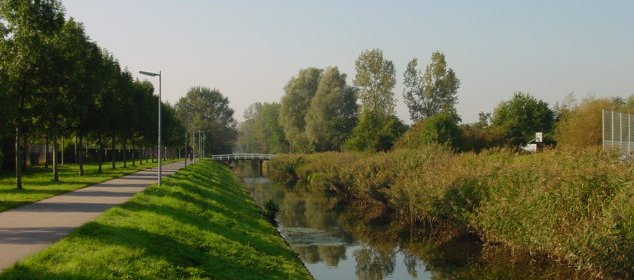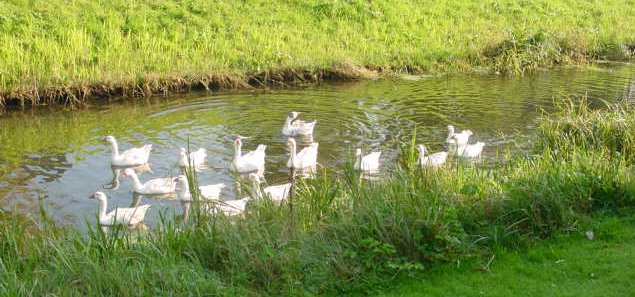I am almost ready to sign my first carbon credit sale on my forests. It is a sweet deal in that I get retro credit for the growth since 2003. The contract is valid for fifteen years from that time, so it runs until 2018. My first thinning on the CP property is 2019 and I will thin the Freeman property in 2011 or 2012. Both are good dates, since the first one will have the contact until the very time of thinning and the second will grow back (i.e. sequester more carbon) in time for the reckoning. The thinning makes the forest grow faster, but it takes a few years to catch up.
Below is Hoofddorp in Holland. During the little ice age, these sorts of canals froze. The don’t any longer. Hoofddorp is a pleasant little town near Amsterdam. There is a Courtyard Marriott there. These pictures are from fall 2006.

I am not sure how the economy will affect the environment. The falling price of gas has already made people less sensitive to using less. As I wrote before, I think we should tax gas back up, but the recession makes that very unlikely scenario even less likely. We made a lot of progress because of higher energy prices and I have to see that lost in the mixture of bad economy and lower energy prices. Global warming is happening and we are part it. Solutions are going to include things like higher energy prices, alternatives and nuclear power, but expect no panacea breakthrough in our lifetimes.
There is nothing we can do to prevent some global warming. Although it might not be so apparent in a cool spell like we have had this year, barring extraordinary volcanic activity or a meteor collision, the earth will be significantly warmer in 2100 than it is today. The best we can do is mitigate it and adapt to the changes. We CAN adapt. I don’t think there is cause for hysteria.
We do not know the details of what will happen, but we can make some general assumptions. We will face sea level rises, water shortages, and changes in weather patterns. The most likely situation will mean that it will be significantly warmer near the poles and somewhat warmer and drier nearer the equator. So what can we do now?
Below – swans in the canal

Some things are simple common sense. For example, if you expect a sea level rise of a couple of feet, do not build permanent structures on land less than a few feet above sea level. For example, we would not rebuild below sea level areas of New Orleans or subsidize building near the ocean in general – no more expensive houses on barrier island or seaside hills. This is fairly easily accomplished. We just should NOT subsidize insurance rates. If people have to pay the real risk premiums, most will not build in the first place. Since trees live a long time, we might also consider planting southern species further north. Genetic engineering will allow plant species to adapt quicker.
My pines, BTW, are indeed a southern species growing near the northern edge of their natural range. I also planted some bald cypress, which are southern trees and maybe I will do some longleaf.
Humans can adapt to climate changes. We evolved during the transition from ice ages to warmer periods. That is one reason we got our big brains. We needed cultural adaptations our intelligence permitted to cope with transformations and new environments that our strictly biological heritage was not quick enough to handle. If you wait to grow fur, you die. If you “borrow” fur from the local animals, you stay warm and alive. Even so, it almost finished off our species. With our more developed technologies the expected climate change will be a cake walk compared to what our troglodyte & and wandering ancestors faced.
We also need some perspective. The earth has been much warmer than it is today … and much colder. Life thrived in the hot Mesozoic and survived during the frigid ice ages. The problem is change itself. Natural and human communities are adapted to today’s world. People and animals can move; forests maybe not. The problem, to repeat, is the change, not the warmer or colder stable state.
Some years from now, our grandchildren might face a far different dilemma than the one we expect. Consider this scenario. What if greenhouse gases have made the world warmer and human & natural communities have begun to adapt to this new stability? What if future generations develop a carbon free panacea of an energy source? Do they see reversing climate change as a benefit or a threat? Maybe at that point they prefer the warmer world and they want to keep it warm with the new weather patterns. After all, we would not want to go back to the colder conditions of the little ice age in 1650 or 1770. That was normal back then. We prefer the climate we have now. Climate change is a problem in either direction.
